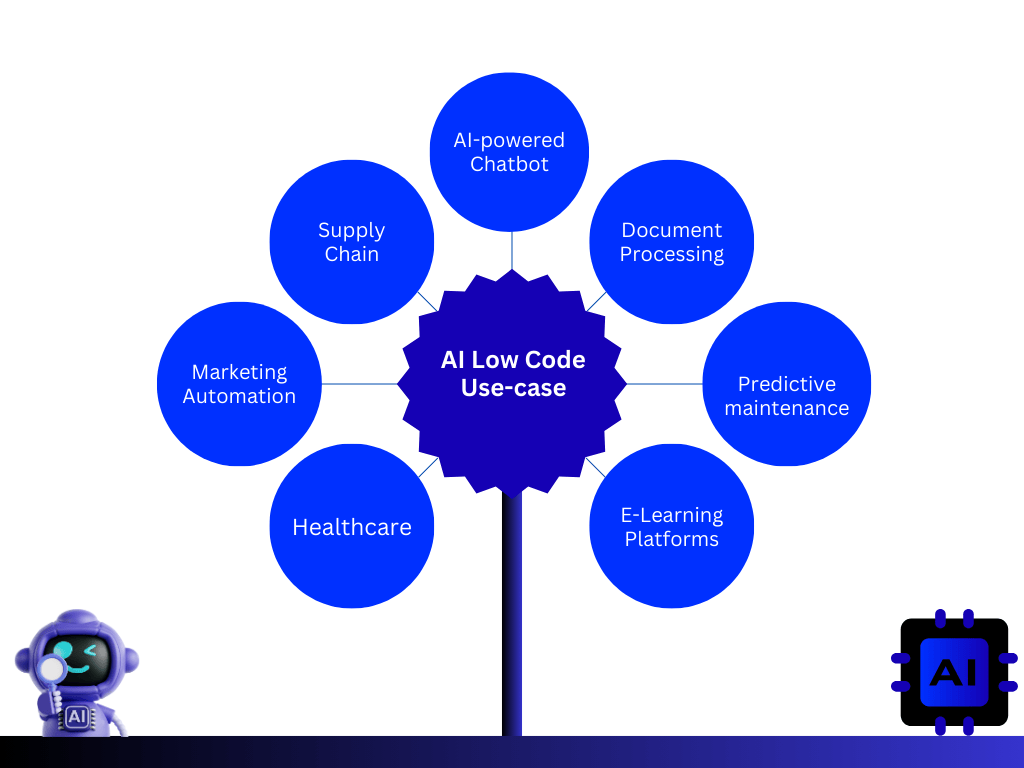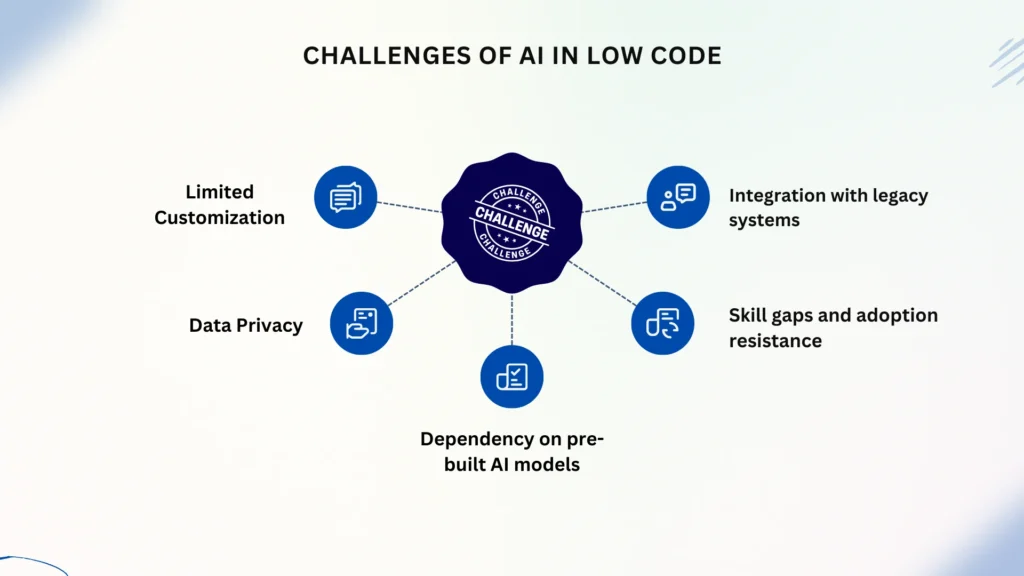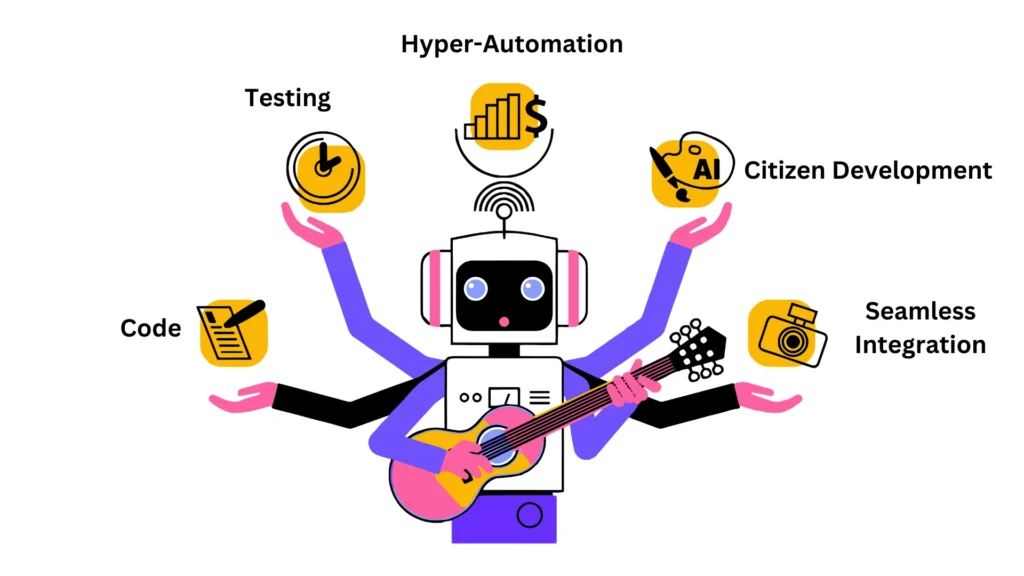What if you could build and deploy robust applications without extensive coding expertise? The answer lies in a solution offering drag-and-drop features, seamless tool integration, and a visual interface. Low-code platforms allow businesses to build solutions efficiently through simple coding methods, which results in fast deployment.
The digital transformation process continues to reshape industries, prompting businesses to innovate their operations and enhance decision-making capabilities. AI functions as a primary catalyst for this transformation by automating complex operations to uncover new business possibilities.
The combination of low-code development with AI delivers advanced technology solutions to organizations of all sizes, bypassing traditional technical barriers to enable them to create intelligent automated systems.
This article explains the concept of low code development and how AI is related. We will discuss the use cases where AI can enhance business operations using AI and future trends.
What Is Low Code Development and how it’s Related to AI?
Low-code development is a software development technique through visual interfaces, drag-and-drop features, and pre-made components. This helps reducing programming efforts and speed up development processes. Users can develop applications through simple workflows instead of writing complex code, expanding development possibilities to less technical users.
The user-friendly interface of low-code platforms simplifies application prototyping, continuous development, and smooth application deployment. This method allows organizations to overcome their dependency on highly skilled developers while simultaneously speeding up digital transformation through IT skills gap bridging.
The built-in features of low-code platforms include native database, cloud service and API connectivity. This helps users to establish seamless application connections. Low-code development provides automated testing control tools to deliver applications efficiently and maintain flexible and scalable systems.
The capabilities of AI strengthen low-code platforms through automated processes, natural language processing, predictive analytics, and machine learning. Low-code applications enhanced by AI can process data efficiently while streamlining workflows.
Low-code platforms with AI assistance enable businesses to automate data processing by using chatbots and enhance decision-making through predictive analytics. The integration enables faster development processes while decreasing expenses and allows more people to create software.
Use Cases of AI in Low Code Platforms
AI integration with low-code platforms enables businesses to develop intelligent applications through automation while requiring minimal development effort.

Here are some of the main use cases of AI in low-code platforms:
– AI-powered chatbots: Low-code platforms with AI integration enable businesses to develop AI-powered chatbots. These chatbots can deliver customer service for responses, order tracking, and make recommendations, thus enhancing customer engagement.
– Efficient document processing: Using AI with low-code applications enables automated data extraction, validation, and document processing, which minimizes human errors. Businesses can process efficient document workflow automation through their drag-and-drop automation tools.
– Predictive maintenance: By combining AI with IoT platforms, it is possible to predict equipment failures, reduce maintenance costs and create real-time monitoring dashboards with alerting systems.
– Personalized learning platforms: AI can deliver customized learning content, improving student engagement. Educational personnel can develop and adjust AI-powered e-learning platforms through user-friendly low-code development tools.
– Healthcare diagnostics: AI-powered low-code applications can evaluate medical data, helping doctors diagnose diseases and track patient health. Hospitals can rapidly establish custom healthcare monitoring tools through low-technical expertise requirements.
– Marketing automation: Businesses can develop AI-based marketing solutions that monitor user activities and generate customized product suggestions. Marketing professionals can modify campaign rules and automation flows through a user-friendly interface that requires no developer assistance.
– Supply chain optimization: Implementing AI in supply chains enables businesses to enhance their operational efficiency in demand forecasting and inventory management while lowering expenses and maintaining proper stock levels.
Benefits of Integrating AI with Low Code
Combining AI with low-code platforms gives businesses multiple benefits to accelerate innovation processes. Here are some of the key benefits:
– Accelerated development and deployment: Application development speeds up through AI automation of coding, debugging, and testing processes, reducing deployment time.
– Enhanced productivity: AI with low code enables developers and non-developers to develop applications through simplified development processes, leading to higher productivity.
– Scalability and flexibility: AI-powered applications with low code provide flexibility to use dynamic systems that adjust to changing business needs, leading to extended scalability.
– Improved decision-making: AI helps organizations make data-based decisions, which improves operational efficiency and enhances customer experiences.
AI with low code provides businesses with improved development processes, reduced costs, and enhanced agility.
Challenges and Limitations of AI in Low-Code Environments
Implementing AI into low-code platforms delivers multiple benefits, but it also comes with challenges.

Here are some of the challenges:
– Limited customization: AI models have limited customization options when using low-code platforms because these platforms do not offer extensive customization features for complex models. The platform configuration limitations prevent developers from creating specialized applications.
– Data privacy: AI applications need massive data processing, which creates problems regarding data privacy, compliance requirements, and security protocols. Protecting sensitive information within low-code environments requires proper handling to sustain user trust and meet regulatory requirements.
– Dependency on pre-built AI models: Using pre-built AI models integrated into low-code platforms might not satisfy business requirements. Due to this dependency, businesses are restricted from modifying these models.
– Skill gaps and adoption resistance: Low-code development aims to make programming accessible to all, but organizations must maintain AI expertise to unlock its full potential. Implementing new technologies faces resistance because they require significant changes to established workflows.
– Integration with legacy systems: Low-code applications employing AI face integration obstacles when connecting with legacy systems because of system compatibility problems and data format requirements. The integration process may cause operational disturbance while developing advanced systems.
Trends and the Future of AI and Low-Code
AI and low-code will keep advancing, promising better business application development methods in the future.

Here are some of the use cases:
– AI-generated code and automation: AI will continue to automate coding through natural language processing to enable users to generate sophisticated applications. This advancement will allow non-technical users to develop applications through a simplified process.
– Expansion of AI-driven testing: AI will enhance automated testing systems, detecting more bugs and creating better software quality. Early detection of development issues through AI-driven testing results in more reliable applications.
– Hyper-automation: Businesses will use AI for complete process automation which reduces the need for human involvement. This will boost operational efficiency and minimize human mistakes in complicated workflow systems.
– AI-driven citizen development: It will enable non-technical users to create applications without requiring traditional programming skills. This transformation will allow more people to participate in development activities, which will lead to faster innovation throughout different industries.
– Seamless integration: Combining AI-powered low-code platforms with emerging technologies like IoT, blockchain, and AR will enable businesses to create innovative solutions for healthcare, finance, and retail sectors.
Organizations that track AI and low-code development trends will be better equipped to navigate the changing technological landscape and achieve innovation and operational efficiency.
Conclusion
Integrating AI and low-code development helps businesses transform their application development, deployment, and management processes. Organizations benefit from enhanced innovation speed, workflow optimization, and better decision-making by uniting AI automation systems with low-code platforms.
Businesses must overcome challenges regarding data security, compliance standards, and AI model customization to maximize the full potential of these technologies. Addressing these limitations will guarantee that AI-powered code applications maintain their scalability alongside security features and adaptability for unique business needs.
Ready to digitally transform your business with AI and Low Code solutions?
At GeneXus Consulting, we design and implement innovative digital solutions that significantly impact your organization. Our team of experts is ready to support you at every stage of your digital transformation journey. Contact us today.



